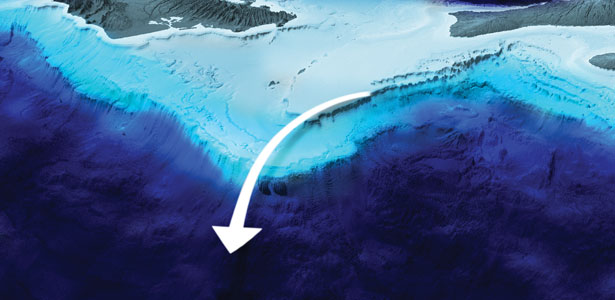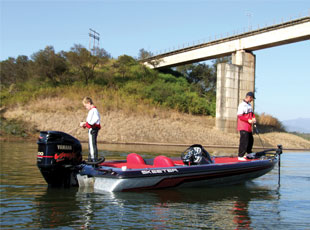
So how many times have you been on your favourite lake, fished your favourite shallow water spots using your top producing lures but left empty handed?
Well, maybe they weren’t biting, maybe you timed it wrong or the weather was not 100%! Probably not - it is highly possible that these fish had moved, moved to the nearest break line or drop-off and taken refuge in the safe sanctuary of the deep!
At the first sign of threat or discomfort, this is normally the primary decision a bass will make. Inconsistent oxygen levels; summer water temperatures, frontal conditions, fishing pressure and seasonal trends are the main factors that send bass super-deep. When faced with one or more of these contributing factors, you could find yourself asking questions you can’t answer. So take the time to learn and accustom yourself with the deep-water habits of bass. Understanding these super-deep habits will often make the difference on pressurized waters and ensure consistent year round catchers. This will elevate your success irrespective of whether you are a seasoned tournament angler or a weekend addict.
When and Why bass go deep?
What do I mean by “deep bass”? I am talking about bass that are too deep to see or react to your medium diving crankbait or weightless soft plastic! As mentioned, understanding the habits of these already hard to target bass is the key to solving your problem. You will not have a shoreline or visible cover to target, so an intimate knowledge of your chosen area, combined with an acute insight as to why these fish have inhabited the deep, is paramount. Without the necessary preparation and perception of the situation you are faced with, effectively targeting deep bass will prove exceptionally difficult.
Seasonal trends are the first influencing factors that drive bass off the edge. In the summer time you will find a reasonable population of bass scattered around the lake. They will eat top waters in the shallows and inhabit visible cover, but what lies offshore remains untapped at this time of year when the majority of the anglers are pounding the banks. Relentless summer heat can cause water temperatures to soar in to the upper 80’s and low 90’s. The population of shallow bass will now only feed with intent in the early and late hours when water temperatures are somewhat cooler. The summer time heat is a great time to move out to the cooler depths of the lake and prospect the main lake structure. As the depth of the water increases, so the water temperature cools, increasing activity levels. This can cause bass to spend most of their time relating to, and mostly suspending, on super-deep cover. This does not mean every deep contour in the lake will support a population of bass, but the key areas within the lake are sure bets. Main lake points, with a major creek or river channel passing close by as well as river channels intersecting the flats would be the starting point for finding deep summer bass. Familiarise yourself with the routes you think these fish might use between their deep-water hangouts and the flats or grass lines they are using to feed.
Bass will use the break line or drop-off as a “highway” and utilise cover along these highways as staging points to the feeding flats. Finding an intersection where a smaller creek channel joins the main channel is most likely going to be the “sweet spot”. Bass will normally follow the same routes on a consistent basis making their movements easier to pattern than you may think!!
Targeting summer time bass is probably the easiest way to get your deep-water confidence up, as these fish are generally more active than deep winter fish for example. Finding schools of deep summer bass can also be reasonably predictable, as you have often solved 50% of the puzzle, namely where they feed! A great way to pattern deep fish at this time of year is to pay close attention to where they feed early in the day. Remember not all the fish feed at the same time, only a percentage of them, which means there are large numbers of fish that are not being pressured. Once you have located shallow fish, start thinking of where they come from so you know where they will be going after they conclude feeding. They will probably lead you to the mother load of deep-water fish. Look for the first major break line adjacent to the flats or points the fish were feeding on. Cruise this break line looking for any changes out of the ordinary. Start marking these spots on your GPS or with marker buoys and continue cruising, paying close attention to your electronics. What you are looking for is a congregation area - this is going to be an intersection in the break line, a secondary break line or drop-off or even a contour change such as a hump. When I am prospecting these areas, at first I will only pay attention to bottom contour (structure); once I am satisfied with my findings, I will zig-zag over these marks looking for timber or rock (cover). Only once I have a clear indication of what I am dealing with, will I start fishing the area with an array of search baits.
To continue seasonal trends, winter is a challenging time to keep up with bass. The best part about the dropping water temperatures is that the fabled saying proves true, namely “ 90% of the fish are located in 10% of the lake”. As suggested winter can cause huge schools of fish to huddle up in concentrated populations on very particular spots. It is imperative that you ensure you are fishing that 10% of the lake where the fish are sitting, digesting the large quantities of forage they have just consumed on the pre-winter feed. After this feed they will often move off shore to where their metabolism will slow down along with the amount of time they spend feeding. They still have to eat, but don’t have to eat as much, so pinpointing their position is vital and a slow methodical approach is needed to coax these fish into biting.
Deep winter areas are very similar to summer areas, but more relative to the main lake. At this time of the year most of the fish will have pulled out of the bays and flats and start relating to major points and main lake drops. Once again use the primary drop-offs as your prospecting contour. Mark as many irregularities in the drop-off as possible but pay extra attention to the most vertical break lines, as these areas are key. The fish really hone in on the vertical ledges, as they hardly need to move in the water column to change depths if needed to feed. Do not be intimidated by searching - follow a drop-off for as far as possible even if it is hundreds of metres passed what you know, as this is often when you will make your most startling discoveries!
At any time of the year, should you find your shallow patterns not holding up due to fishing pressure, frontal conditions or factors you cannot explain, then head off shore and target these same areas. The shortcut to finding deep productive water is preparation and on the water fine-tuning.
Targeting Deep bass
Up until now your deep water approach has been preparation and planning, and now is the time to start casting. Hide your topwaters and jerkbaits as you are going deep, at times in excess of 40ft. That’s right, if the combination of aspects you have put together allow this, the fish will be there. Most of the time the areas you will have located will be in the 15-30ft zone, but deeper fish are there for the picking.

Presuming you understand exactly what you are targeting and have an intimate outlook on the spot you have chosen, selecting the correct bait will be second nature. Remember back to how you found the spot. The areas between your markers should be Carolina rigged or cranked because these baits cover deep water fast. A 1\2-1oz weight is a necessity for the Carolina and a fluorocarbon leader will ensure more bites. Opt for plastic baits that float up off the bottom appealing to fish that may be slightly suspended. Your crankbait will normally be a DD22, because if you are fishing a shallower crank, then you are not fishing deep.
Once you approach one of the key spots within the area change up to a more directly presented bait. My favourite baits for deep situations like this would be a 1\2oz Picasso Football Jig and a Picasso Shak-e Football Head. Both of these baits sink fast and are phenomenal producers of deep bass. I will throw the Shake-e on 8lb line and rig it with a 6-inch finesse style plastic bait. The jig will be used on 15lb line. Colours will normally consist of darker hues to create a larger silhouette in the deep, dark water. You need to keep your bait in the strike zone for as long as possible and make multiple casts from different angles until they bite.
Other excellent options for enticing deep fish are Texas rigged plastics, drop-shot plastics and slow rolled spinnerbaits weighing in at up to an ounce.
Positioning your boat correctly is also vital but varies. You first of all need to determine which side of the cover or contour the fish are holding on, or whether they are suspended or sitting on the bottom. The only way to get these answers is by getting bites - take mental notes when you get a bite so you duplicate your boat position and presentation.
The 2009 Inanda Classic was a classic example of how shallow fish can move deep with no warning. My partner Garth Liefeldt and I (Team Ruff Thumb) were defending our team title for the same tournament from 2008. In pre-fishing we had patterned some good schools of shallow fish that were feeding heavily in the mornings. A mere two degree drop in water temperature and 160 boats had shut our shallow fish down and had us fishless by 11:00 am on day 1. Confident that the fish had vacated the shallows we moved off shore and targeted a creek channel adjacent to a large flat. I started with a Fat Free Shad and no sooner after it bottomed out at 15ft I was bending on a good fish. At just short of 2kg it was a huge turnaround for us. A few casts later and Garth had boated a 1,4kg fish. We had a limit, which was 2 fish per team per day and we were now ready to cull them out. I held the boat parallel to the break line and we fired our baits along the deeper edge of the drop. The bite slowed, so I made a change, a sure way to ignite the school again. One cast with a 3\8oz Picasso slow rolled spinnerbait was all it took, a huge fish had eaten it and was not excited about been live welled. The nearby boats had been drawn in by all the action and watched curiously as I patiently played fought the fish. We breathed a sigh of relief when we netted the 3.1kg fish, which now had us in the running for a shot at the heaviest bag. We were not done yet though - I never made another cast with the spinnerbait and instead launched my 1\2oz Picasso Football Jig in PB&J. The boats had now moved in close enough to check the colour of my jig trailer and were therefore disgusted when I set the hook again, and boated a 2,3kg fish. We now had 5.4kg for two fish and were almost guaranteed a top five finish for the first day.
On day 2 we once again allowed our shallow water pattern to take effect, which it didn’t. We moved to the same area as day 1 but believe it or not the fish had moved. Although they were not where they were the day before, I knew they would be using the same route in between the flats and drop-off. We moved further off shore and marked the intersection of the creek channel and main river channel and targeted a brush pile on the outside bend in 25ft of water. The first fish, which fell victim to my PB&J Football Jig, weighed 2,6kg. Garth was using a Picasso Shak-E Head loaded with a 6”Trick worm. I saw him rear back as hard as his 8lb-spinning outfit would allow. The fish peeled line and jumped at the end of a long run. We would win with this fish and we knew it, so we took no chances and played the fish carefully and persistently. After a good few minutes I netted the 3,4kg fish for Garth, which peaked our 2-day weight at 11,4kg for 4 fish. We won by 3kg clear and claimed our second consecutive Inanda Classic team win. This win was testament to how versatility is fundamental in bass fishing and how knowledge of the transition bass make between shallow and deep must be understood to capitilise.
The Importance of Electronics
Remember you cannot see what you are fishing so you will find yourself relying on your electronics. This is no time to skimp on your equipment. My boat is equipped with the pinnacle in Garmin GPS and sonar technology. I use a pair of Garmin Map 525S Combo units that allow me to split screen between Sonar and GPS. This means I can cruise a contour and mark the key spots with one touch of a button. A 5-inch high resolution colour display interprets bottom density making it easier to differentiate between bottom composition. Add an electronic topographical mapping card to your outfit and you are ready to locate any spot anywhere at any depth! 
I hope your confidence in deep water fishing is now on the up - once again do not be intimidated by what you don’t know or cannot see. Get out on the lake and spend time sharpening your deep-water skills and broadening your fishing horizons. Versatility is of the utmost importance so ensuring your approach to deep bass is refined will make you more successful. Wherever possible do not rush deep fish to the surface - allow them time to equalize pressure on the way up therefore guaranteeing a healthy release. If you are fishing a tournament and are not familiar with fizzing (pricking) bass then do not hesitate to weigh the fish in so the weigh master can fizz the fish. We need to protect our dwindling resource, if we don’t nobody else will!


 Visit us our
Visit us our